原始图像在成像和传输过程中,往往会引入噪声,从而导致图像质量下降和图像信息的丢失[1-3]. 为了提高图像质量,方便后续的图像处理过程[4],如图像识别、去雾[5]、重建[6]和超分辨[7]等,图像降噪显得非常重要[8-11]. 在降噪过程中,需要知道噪声的分布模型和参数. 一般假设图像噪声为零均值高斯白噪声,这时需要估计的参数就是噪声方差.
噪声方差估计常用的方法如下:基于图像平滑块的噪声方差估计、基于主成分分析的噪声水平估计、基于小波变换的噪声标准方差估计. 例如,汪浩然等[12]提出了一种平滑图像块筛选方法,将其与奇异值分解相结合实现对图像的噪声标准差估计. Pyatykh等[13]提出了主成分分析方法,无需图像中存在平滑块,可以对细节丰富的图像进行噪声估计. Fahmy等[14]提出了一种基于双边树复杂小波变换的增强去噪方法.
小波变换是一种对图像进行多分辨率分析的方法. 小波变换后图像的信息主要集中在低频部分,而高斯白噪声在整个频域具有相同的分布,可以根据高分辨率的细节系数来估计噪声. 1994年,Donoho根据噪声的统计特性,提出基于小波变换的图像噪声方差估计方法[15]. 这种方法由于原理简单、结果比较准确,在图像去噪领域得到广泛的研究和应用[16-19].
Donoho方法在图像噪声较大的时候较为准确,但是在图像噪声较小、图像细节较丰富时估计结果普遍偏大. 随着成像技术的进步,图像噪声逐渐减小,对较小的噪声进行准确估计变得极为重要. 现在已经出现一些改进的噪声方差估计方法[20-22],比如林泽民[20]提出用EM算法来估计混合高斯模型的参数,但是这些算法应用较为复杂.
为了在去除噪声的同时尽可能地保留图像的细节信息,本文对大量的常用图像进行加噪模拟,从而在Donoho方法的基础上提出一种新的估计方法. 该方法首先使用小波变换得到一个噪声标准方差的初始估计值,然后根据不同大小的噪声对小波细节系数的影响,将得到的估计值进行分段处理得到最终估计值,最后利用本文得到的方差估计值进行小波阈值去噪. 本文方法无需复杂的计算,直接对图像的小波细节系数进行分段处理就可以在噪声较小时得到比较准确的估计.
1 噪声方差估计原理 1.1 基于小波变换的噪声估计原理假设图像经过噪声污染后,表达式如下:
| $y = x + n.$ | (1) |
式中:
将数字图像进行多尺度二维离散小波变换后,可以得到该尺度下的近似系数(低频分量)和3组细节系数:水平、垂直和对角线细节系数. 在图像较为平滑时,图像的能量主要集中在低频部分,而噪声在整个频域具有相同的分布,因此可以将高频分量认为主要是噪声引起的[25-27]. Donoho根据小波变换的特性,提出图像噪声标准方差的估计方法:
| ${e_{\rm{D0}}} = M/{\rm{0}}{\rm{.674\;5}}{\rm{.}}$ | (2) |
式中:
Donoho方法是小波噪声估计的传统方法,因此下文中提到的传统方法均为Donoho方法. 由第1.1节可知,传统方法假设的是图像经过小波变换后在对角线方向的细节系数非常小,相比于噪声可以忽略不计. 在噪声较大时,这个假设可以被很好地满足. 但是当噪声相对较小时,图像的细节信息就不能完全忽略了. 可以推断,此时由于受到了图像细节的影响,按照传统的Donoho方法估计出的噪声标准方差值就会偏大,并且噪声越小其影响越大.
为了验证这个猜想,首先对50幅常用图像进行加噪模拟实验,观察传统方法噪声估计值的变化规律. 本文所有用到的噪声标准方差的单位均为像素值,比如,标准差为5代表着5个像素值. 对每张图像都施加从0到30变化的零均值高斯白噪声,分别计算每张图像在每一个噪声水平下的eD0. 计算在每一个噪声水平下,所有图像的eD0的平均值eD. 实验发现,估计值的平均值随着实际噪声标准差变化具有比较明显的线性趋势,如图1所示. 图中,
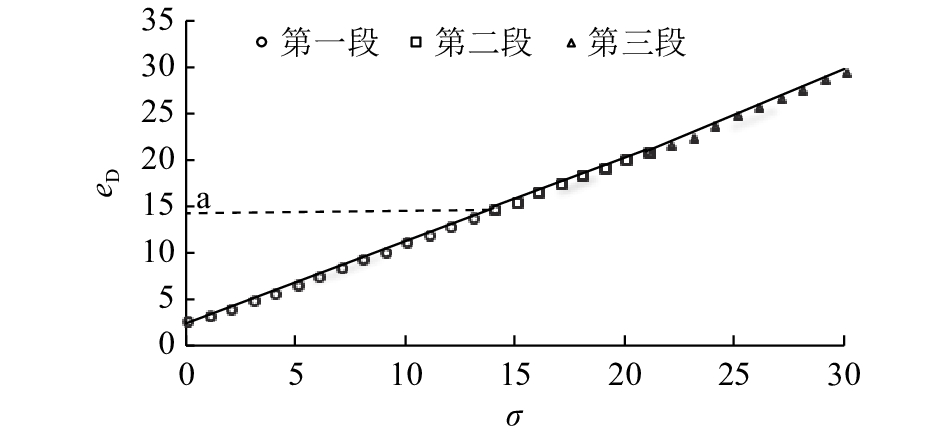
|
图 1 传统方法对50幅图像的噪声估计结果 Fig. 1 Noise estimation results of fifty images by traditional method |
当
反推出的函数的关键在于分段函数的2个临界值,由于当
为了验证上述规律,接着对500幅常用图像进行加噪模拟实验. 对图像分别施加标准差从0到30变化的零均值高斯噪声,然后采用传统的估计方法对含噪图像的噪声标准方差进行估计. 实验发现,基本变化趋势和最初用50张图像进行实验的结果相似. 特别是在
| $e = \left\{ {\begin{array}{*{20}{c}} {\left( {{e_{\rm{D0}}} - 2.547\;0} \right)/0.875\;9},&\!\!\!\!\!\!\!\!\!\!\!\!\!\!\!\!\!{{e_{\rm{D0}}} < 15}; \\ {\left( {{e_{\rm{D0}}} - 2.475\;8} \right)/0.887\;9},&{15 \leqslant {e_{\rm{D0}}} < 21}; \\ \!\!\!\!\!\!\!\!\!\!\!\!\!\!\!\!\!\!\!\!\!\!\!\!\!\!\!\!\!\!\!\!\!\!\!\!\!\!\!\!\!\!\!\!\!\!\!\!\!\!\!\!\!\!\!\!\!\!\!\!\!\!\!\!\!\!\!\!\!\!\!\!{{e_{\rm{D0}}}},&\!\!\!\!\!\!\!\!\!\!\!\!\!\!\!\!\!{{e_{\rm{D0}}} \geqslant 21} .\end{array}} \right.$ | (3) |
式中:
对于上述统计时用到的图像,根据式(3),本文的估计效果如图2(数据点及拟合曲线)所示. 图中还给出了用一次函数拟合的
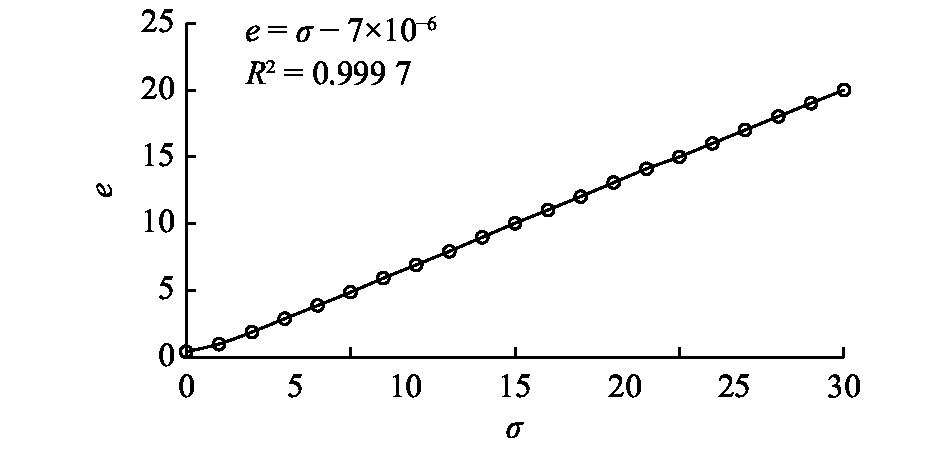
|
图 2 本文算法对统计时训练图像的估计结果 Fig. 2 Noise estimation results of the training images by proposed algorithm |
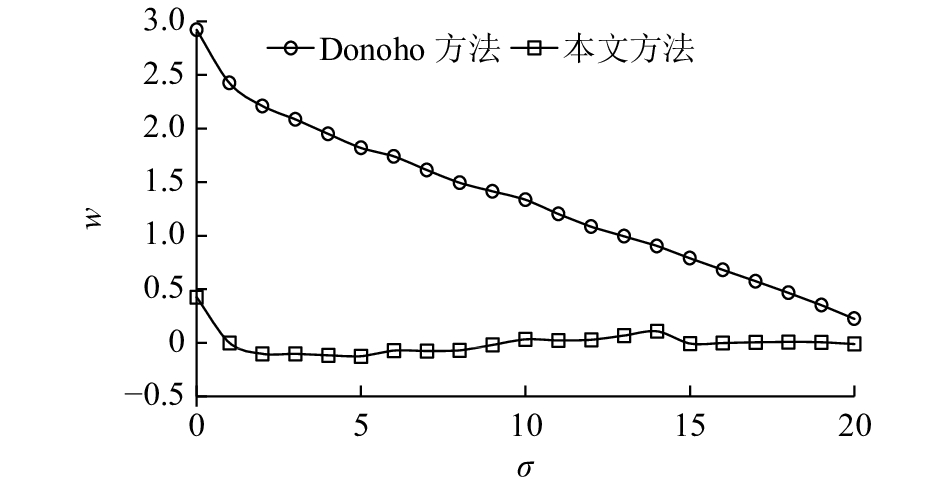
|
图 3 本文算法和Donoho算法对实际噪声标准差的估计误差比较 Fig. 3 Error comparison of proposed algorithm and Donoho algorithm for actual noise standard deviation |
对一幅带噪图像进行噪声标准方差估计的具体步骤如下:
1)选用
2)采用式(2)进行噪声标准方差估计,得到初始估计值
3)将不同的初始估计值代入式(3),得到最终估计值
1)根据得到的噪声标准方差估计值
2)用T对小波系数进行软阈值去噪处理,得到新的小波系数,并对新的小波系数进行重构,得到去噪图像.
图像去噪效果的主观评价标准为肉眼观察图像质量,客观评价标准常用峰值信噪比(peak signal to noise ratio, PSNR)来评价,表达式如下:
| ${\rm{PSNR}} = 10\;{\log _{10}}\;\left( {{{mn \cdot P_{\max }^2}}{{\displaystyle\sum\limits_{i = 0}^{m - 1} {\displaystyle\sum\limits_{j = 0}^{n - 1} \;{{{\left( {{I_{ij}} - {J_{ij}}} \right)}^2}} } }}} \right).$ | (4) |
式中:
为了验证本算法,在Matlab中进行仿真实验. 选取50幅常用的标准测试图片,分别施加标准差从0到20每次变化1个像素的高斯白噪声,然后分别采用传统方法和本文方法进行估计. 噪声标准差估计值的均值与真实值之间的关系如图4所示,估计误差如图5所示.
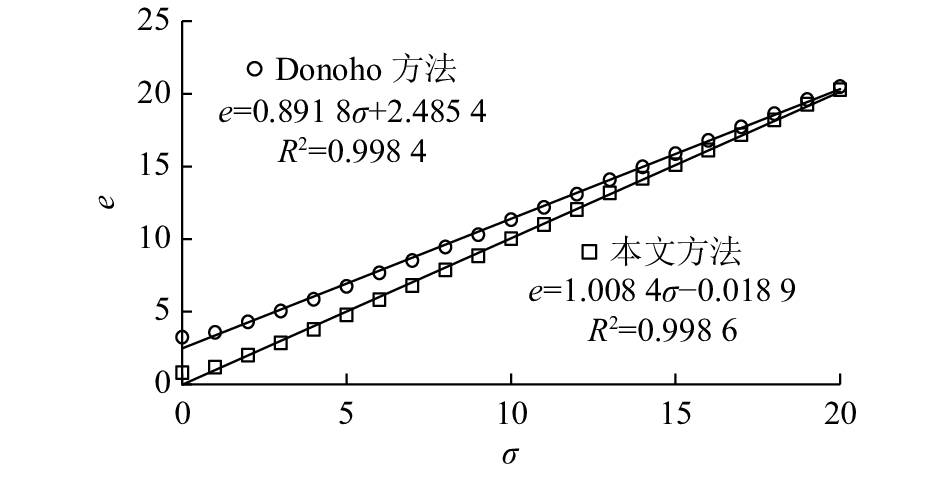
|
图 4 传统算法与本文算法估计测试图像噪声的结果 Fig. 4 Noise estimation results of test images by traditional algorithm and proposed algorithm |
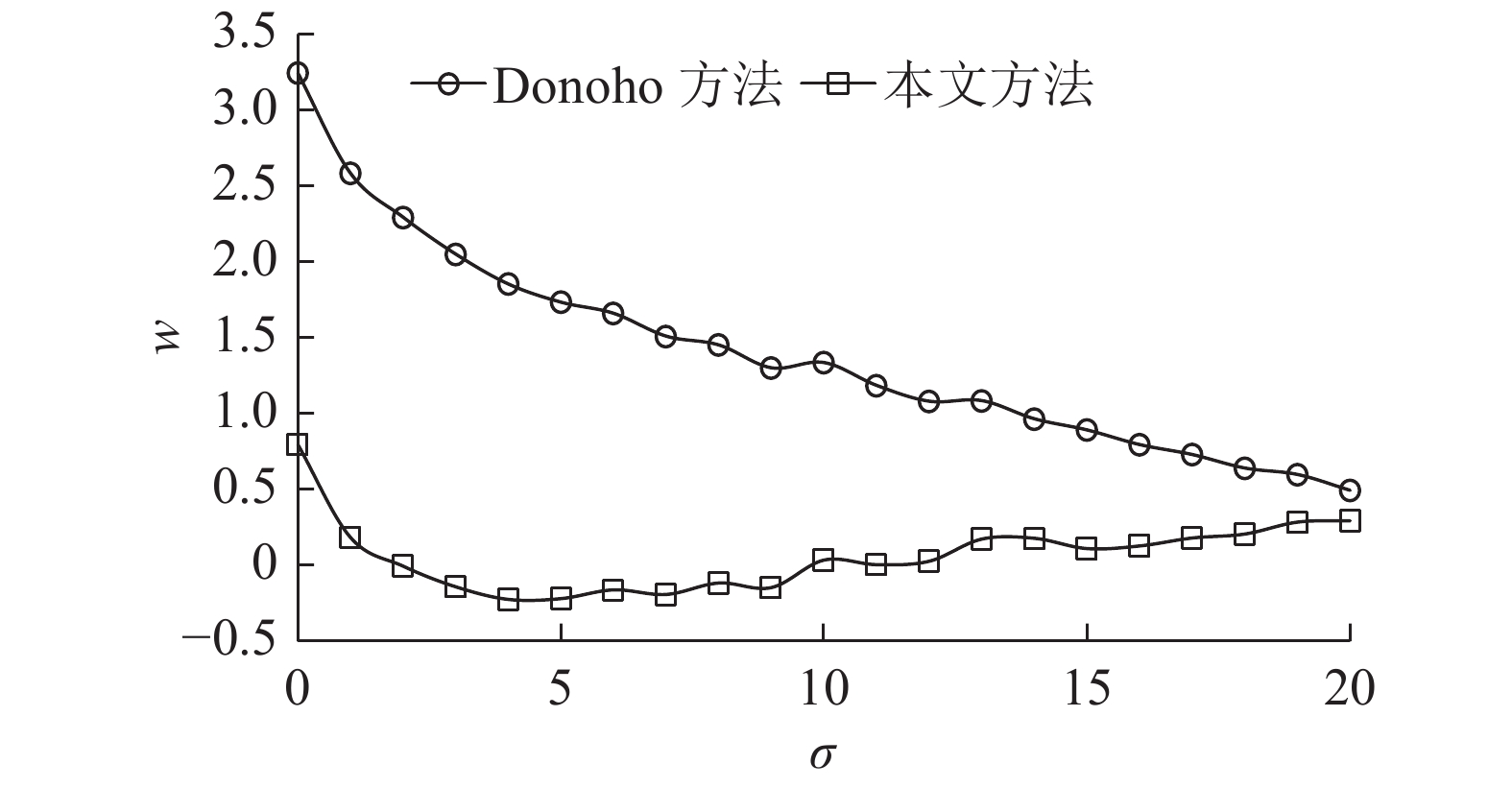
|
图 5 传统方法与本文方法对测试图像噪声标准差估计的 误差比较 Fig. 5 Error comparation of traditional method and proposed method to estimate noise standard deviation of test images |
由图4、5可得,本文方法在所有噪声水平下对噪声标准方差估计的均值都比传统方法更接近真实值. 当图像噪声较小时,图像细节容易被错误估计为噪声,导致噪声估计值偏大。传统方法估计值在噪声越小时误差越大,这说明传统方法受图像细节影响较大,对小噪声估计不准确。本文方法在噪声较小时估计值误差也比较小,因此本文方法对噪声较小、细节信息丰富的图像效果比传统方法好.从图5还可以发现,本文方法的估计值误差方差比传统方法小,说明本文方法的估计值误差波动更小,方法更稳健.为了便于直接观察具体数据,将部分估计结果列于表1中,

|
图 6 噪声标准差估计实验的部分实验图像 Fig. 6 Some experimental images used in noise standard deviation estimation experiments |
对如图6所示的4幅实验图像进行去噪处理. 根据本文方法估计出的噪声标准差利用小波软阈值方法进行去噪,并将去噪性能与传统方法进行比较. 如图7所示为对图6(a)用传统方法和本文方法进行小波阈值去噪的结果. 其中,PSNR1指的是加入噪声后的图像相对于原始高质量图像的PSNR,PSNR2指的是用传统方法去噪后所得图像的PSNR,PSNR3指的是用本文方法去噪后所得图像的PSNR. 对另外3张图片进行小波阈值去噪后的现象与Woman图片类似,所以本文就只附上部分噪声水平下的去噪情况,如图8所示.

|
图 7 传统方法和本文方法对Woman图像的去噪性能比较 Fig. 7 Comparison of denoising performance of Woman image between traditional method and proposed method |
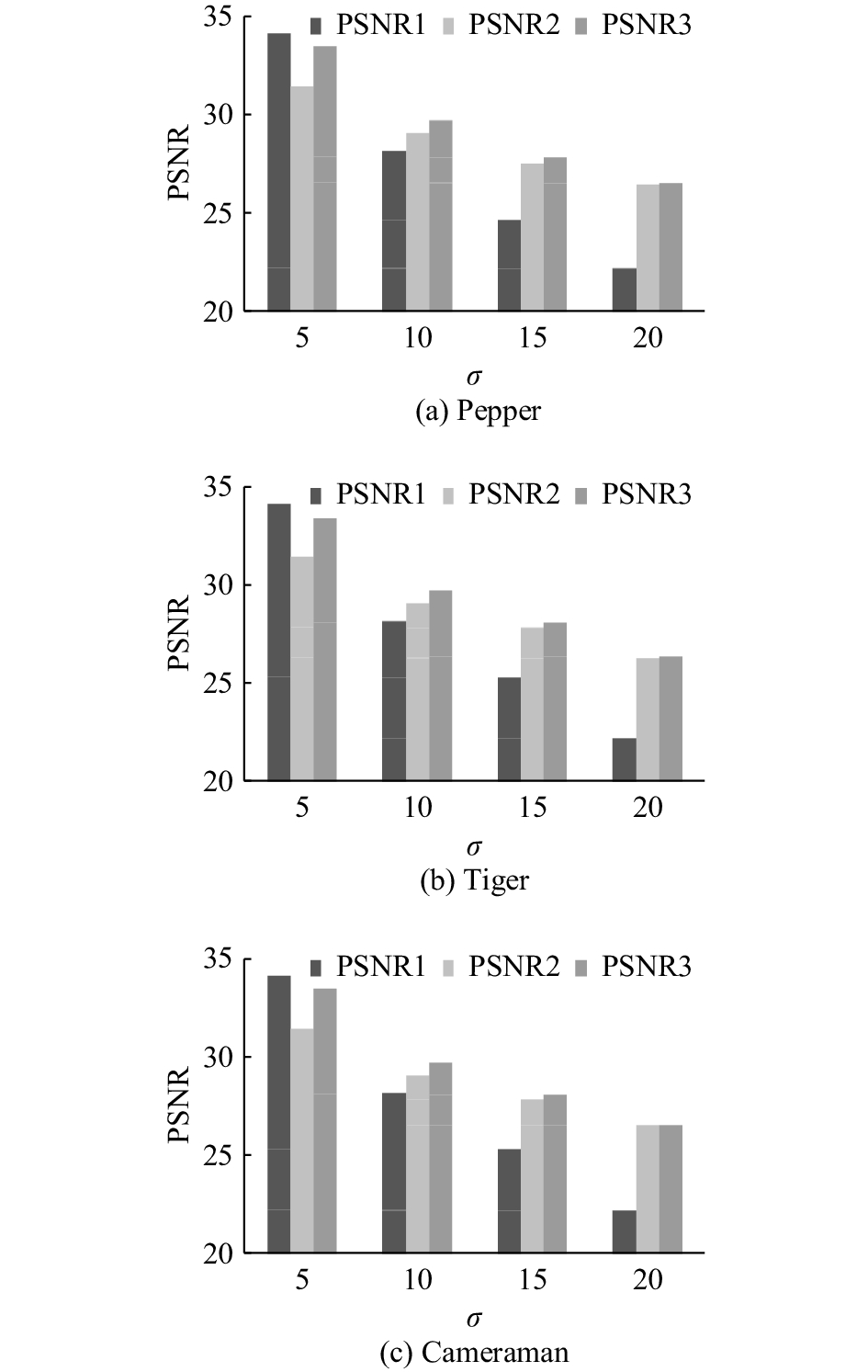
|
图 8 传统方法和本文方法对Pepper、Tiger和Cameraman图像的去噪性能比较 Fig. 8 Comparison of denoising performance of image Pepper, tiger and Cameraman between traditional method and proposed method |
从图7可以看出,对于图6(a),用本文方法得到的标准差进行小波阈值去噪,去噪后图像的PSNR比传统方法高,在噪声小时尤为明显. 将本文方法估计出的噪声标准差作为小波阈值去噪的输入参数,当
为了更直观地看出降噪效果,本文对图6中的4张实验图像分别施加标准方差为10的高斯噪声,然后使用小波软阈值去噪. 被噪声污染的含噪图像、分别使用传统方法和本文方法进行小波软阈值去噪后的图像如图9所示. 从图9中可以看出,当

|
图 9 含噪图像、传统方法去噪后图像与本文方法去噪后 图像的比较 Fig. 9 Comparison of noisy images, images denoised by traditional methods and images denoised by proposed method |
本文提出了一种改进的图像噪声水平估计方法,一定程度上解决了在图像噪声较小时对噪声方差估计不准确的问题. 本文通过对图像小波变换后对角线方向的细节系数进行分段处理得出噪声标准差,并将估计出的噪声标准差用在小波阈值去噪中. 实验表明,对图像噪声标准差估计时,本文方法比传统估计方法更准确,误差均值更小更稳定. 用本文方法估计出的噪声方差进行小波阈值去噪,去噪后图像质量更好,PSNR提升更明显,证明了所提算法能够有效地提升降噪后图像的清晰度,保留图像细节.
| [1] |
ZHANG D, ZHAO L, XU D, et al. A neural network based low-light image denoising method [C] // 2017 3rd IEEE International Conference on Computer and Communications (ICCC). Chengdu: IEEE, 2017: 1868–1872.
|
| [2] |
KIMLYK M, UMNYASHKIM S. Image denoising using discrete wavelet transform and edge information [C] // 2018 IEEE Conference of Russian Young Researchers in Electrical and Electronic Engineering (EIConRus). Moscow: IEEE, 2018: 1823–1825. https://www.researchgate.net/publication/323860301_Image_denoising_using_discrete_wavelet_transform_and_edge_information
|
| [3] |
XU J, ZHANG L, ZHANG D. External prior guided internal prior learning for real-world noisy image denoising[J]. IEEE Transactions on Image Processing, 2018, 27(6): 2996-3010. DOI:10.1109/TIP.2018.2811546 |
| [4] |
CHANDNI C S, PUSHPAKUMARI R. Reduced hardware architecture of bilateral filter for real time image denoising [C] // 2017 International Conference on Intelligent Computing, Instrumentation and Control Technologies (ICICICT). Kannur: IEEE, 2017: 769–774. https://www.researchgate.net/publication/241176466_Structure_Enhancing_Bilateral_Filtering_of_Images
|
| [5] |
WANG Z, HOU G, PAN Z, et al. Single image dehazing and denoising combining dark channel prior and variational models[J]. IET Computer Vision, 2018, 12(4): 393-402. DOI:10.1049/iet-cvi.2017.0318 |
| [6] |
YUAN H, JIA J, ZHU Z. SIPID: A deep learning framework for sinogram interpolation and image denoising in low-dose CT reconstruction [C] // 2018 IEEE 15th International Symposium on Biomedical Imaging. Washington: ISBI, 2018: 1521–1524.
|
| [7] |
郭丙华, 岑志松. 小波去噪和神经网络相融合的超分辨率图像重建[J]. 激光杂志, 2013, 37(2): 61-64. GUO Bing-hua, CEN ZHI-song. Super resolution image reconstruction based on wavelet denoising and neural network[J]. Laser Journal, 2013, 37(2): 61-64. DOI:10.3969/j.issn.0253-2743.2013.02.032 |
| [8] |
杨涛, 方帅, 程文娟. 基于熵的图像噪声方差估计[J]. 中国科学技术大学学报, 2015, 45(4): 337-344. YANG Tao, FANG Shuai, CHENG Wen-juan. Entropy-based image noise variance estimation[J]. Journal of University of Science and Technology of China, 2015, 45(4): 337-344. DOI:10.3969/j.issn.0253-2778.2015.04.012 |
| [9] |
TEODORO A M, BIOUCASDIAS J M, FIGUEIREDO M A T. Image restoration with locally selected class-adapted models [C] // 2016 IEEE 26th International Workshop on Machine Learning for Signal Processing (MLSP). Vietri sul Mare: IEEE, 2016: 1–6. https://www.researchgate.net/publication/303449222_Image_Restoration_with_Locally_Selected_Class-Adapted_Models
|
| [10] |
HANS W J, VENKATESWARAN N, NARAYANAN S, et al. Fast Single Image super-resolution algorithm using feature based regression analysis [C]// 2016 International Conference on Wireless Communications, Signal Processing and Networking (WiSPNET). Chennai: IEEE, 2016: 509–514. http://www.deepdyve.com/lp/institute-of-electrical-and-electronics-engineers/fast-single-image-super-resolution-algorithm-using-feature-based-Jgyn7epDTF
|
| [11] |
BATZ M, KOLODA J, EICHENSEER A, et al. Multi-image super-resolution using a locally adaptive denoising-based refinement [C] // International Workshop on Multimedia Signal Processing (MMSP), Montreal: IEEE, 2017: 1–6. https://www.researchgate.net/publication/312485755_Multi-image_super-resolution_using_a_locally_adaptive_denoising-based_refinement
|
| [12] |
汪浩然, 夏克文, 牛文佳, 等. 结合分块噪声估计的字典学习图像去噪算法[J]. 计算机应用研究, 2017, 34(10): 3153-3156. WANG Hao-ran, XIA Ke-wen, NIU Wen-jia, et al. Image denoising algorithm combined with dictionary learning and blocked-based noise estimation[J]. Application Research of Computers, 2017, 34(10): 3153-3156. DOI:10.3969/j.issn.1001-3695.2017.10.060 |
| [13] |
PYATYKH S, HESSER J, ZHENG L. Image noiselevel estimation by principal component analysis [J]. IEEE Transactions on Image Processing, 2013, 22(2): 687-699. https://www.researchgate.net/file.PostFileLoader.html?id=57e17e1d3d7f4b488319b7cb&assetKey=AS%3A408459230105602%401474395677530
|
| [14] |
FAHMY M F, FAHMY O M. An enhanced denoising technique using dual tree complex wavelet transform [C] // Radio Science Conference. Aswan: IEEE, 2016: 205–211. https://www.researchgate.net/publication/297716449_An_Enhanced_Denoising_Technique_Using_Dual_Tree_Complex_Wavelet_Transform
|
| [15] |
DONOHO D L, JOHNSTONE J M. Ideal spatial adaptation by wavelet shrinkage[J]. Biometrika, 1994, 81(3): 425-455. DOI:10.1093/biomet/81.3.425 |
| [16] |
GONG T R, YANG Z J, WANG G S, et al. A SURE based sub-band adaptive denoising method [C] // 2016 2nd IEEE International Conference on Computer and Communications (ICCC). Chengdu: IEEE, 2016: 2637–2640.
|
| [17] |
王泉德, 肖继来, 谢晟. BOLD效应fMRI图像的自适应阈值小波去噪方法[J]. 计算机工程与应用, 2017, 53(8): 170-173. WANG Quande, XIAO Ji-lai, XIE Shen. Wavelet denoising algorithm with adaptive threshold for fMRI imagesbased on BOLD effect[J]. Computer Engineering and Applications, 2017, 53(8): 170-173. |
| [18] |
易清明, 陈明敏, 石敏. 一种改进的小波去噪方法在红外图像中应用[J]. 计算机工程与应用, 2016, 52(1): 173-177. YI Qing-ming, CHEN Ming-min, SHI Min. Improved wavelet de-noising method for infrared image application[J]. Computer Engineering and Applications, 2016, 52(1): 173-177. DOI:10.3778/j.issn.1002-8331.1401-0082 |
| [19] |
文奴, 杨世植, 崔生成. 基于Curvelet-Wavelet变换高分辨率遥感图像降噪[J]. 浙江大学学报: 工学版, 2015, 49(1): 79-86. WEN Nu, YANG Shi-zhi, CUI Sheng-cheng. High resolution remote sensing image denoising based on Curvelet-Wavelet transform[J]. Journal of Zhejiang University: Engineering Science, 2015, 49(1): 79-86. |
| [20] |
林哲民, 康学雷, 张立明. 在小波域中进行图像噪声方差估计的EM方法[J]. 红外与毫米波学报, 2001, 20(3): 199-202. LIN Zhe-ming, KANG Xue-lei, ZHANG Li-ming. EM algorithm for estimating the noise deviation of the image in the wavelet domain[J]. Infrared Millim Waves, 2001, 20(3): 199-202. DOI:10.3321/j.issn:1001-9014.2001.03.009 |
| [21] |
CHEN G, ZHU F, HENG P A. An efficient statistical method for image noise level estimation [C] // IEEE International Conference on Computer Vision. Santiago: IEEE, 2015:477-485. https://www.researchgate.net/publication/300408389_An_Efficient_Statistical_Method_for_Image_Noise_Level_Estimation
|
| [22] |
XU S, ZENG X, JIANG Y, et al. A multiple image-based noise level estimation algorithm [J]. IEEE Signal Processing Letters, 2017, 24(11):1701-1705. https://www.researchgate.net/publication/319996245_A_multiple_image-based_noise_level_estimation_algorithm
|
| [23] |
DENG L, FANG Q, ZHU H, et al. Image denoising based on spatially adaptive high order total variation model [C] // 2016 9th International Congress on Image and Signal Processing, Datong: BioMedical Engineering and Informatics (CISP-BMEI), Datong: IEEE, 2016: 212–216. https://www.researchgate.net/publication/313802994_Image_denoising_based_on_spatially_adaptive_high_order_total_variation_model
|
| [24] |
徐鑫, 田逢春, 姬艳丽, 等. 基于小波系数层间相关性的图像噪声方差估计[J]. 计算机应用, 2009, 29(10): 2674-2677. XU Xin, TIAN Feng-chun, JI Yan-li, et al. Noise variance estimation based on inter-scale correlation of image coefficient of wavelet transform[J]. Journal of Computer Applications, 2009, 29(10): 2674-2677. |
| [25] |
李天翼, 王明辉, 常化文, 等. 基于熵检测的图像噪声方差小波域估计[J]. 北京邮电大学学报, 2011, 34(5): 1-5. LI Tian-yi, WANG Ming-hui, CHANG Hua-wen, et al. An entropy-based estimation of noise variance in wavelet domain[J]. Journal of Beijing University of Posts and Telecommunications, 2011, 34(5): 1-5. |
| [26] |
彭广民, 陈婷. 基于Matlab小波去噪的研究方法[J]. 测绘与空间地理信息, 2016, 39(7): 24-26. PENG Guang-ming, CHEN Ting. Wavelet denoising methods based on Matlab[J]. Geomatics & Spatial Information Technology, 2016, 39(7): 24-26. DOI:10.3969/j.issn.1672-5867.2016.07.007 |
| [27] |
吴雅朋, 蒋章雷, 王吉芳, 等. 改进小波降噪算法在轴承缺陷图像的应用[J]. 组合机床与自动化加工技术, 2017(11): 65-68. WU Ya-peng, JIANG Zhang-lei, WANG Ji-fang, et al. Application of improved wavelet de-noising algorithm for bearing defect image[J]. Modular Machine Tool & Automatic Manufacturing Technique, 2017(11): 65-68. |



